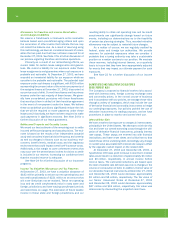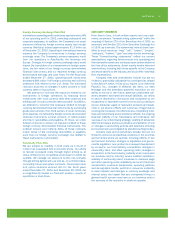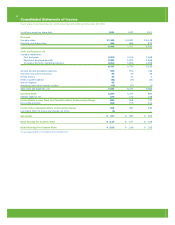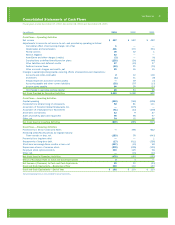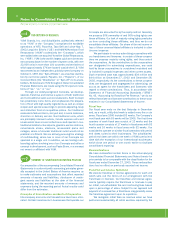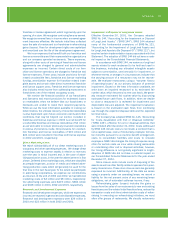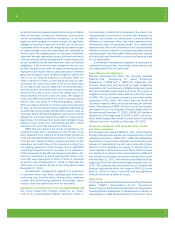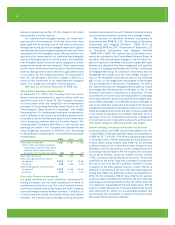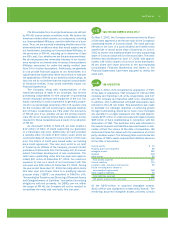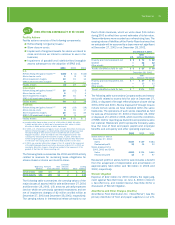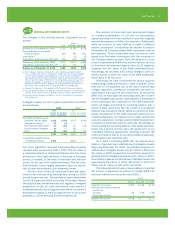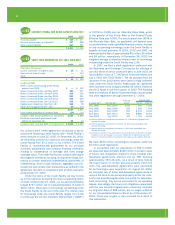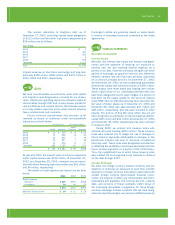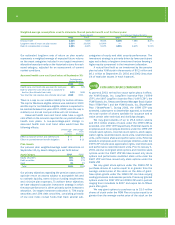Pizza Hut 2003 Annual Report Download - page 58
Download and view the complete annual report
Please find page 58 of the 2003 Pizza Hut annual report below. You can navigate through the pages in the report by either clicking on the pages listed below, or by using the keyword search tool below to find specific information within the annual report.
56.
deemed impaired and written off. The charge of $5 million
was recorded in facility actions.
For indefinite-lived intangible assets, our impairment
test consists of a comparison of the fair value of an intan-
gible asset with its carrying amount. Fair value is the price a
willing buyer would pay for the intangible asset and is gener-
ally estimated by discounting the expected future cash flows
associated with the intangible asset. We also perform our
annual test for impairment of our indefinite-lived intangible
assets at the beginning of our fourth quarter. Our indefinite-
lived intangible assets consist of values assigned to certain
trademarks/brands we have acquired. When determining
the fair value, we limit assumptions about important factors
such as sales growth to those that are supportable based
on our plans for the trademark/brand. As discussed in
Note 12, we recorded a $5 million charge in 2003 as a
result of the impairment of an indefinite-lived intangible
asset. This charge was recorded in facility actions.
See Note 12 for further discussion of SFAS 142.
Stock-Based Employee Compensation
At December 27, 2003, the Company had four stock-
based employee compensation plans in effect, which are
described more fully in Note 18. The Company accounts
for those plans under the recognition and measurement
principles of Accounting Principles Board Opinion No. 25,
“Accounting for Stock Issued to Employees,” and related
Interpretations. No stock-based employee compensation
cost is reflected in net income, as all options granted under
those plans had an exercise price equal to the market value
of the underlying common stock on the date of grant. The
following table illustrates the effect on net income and
earnings per share if the Company had applied the fair
value recognition provisions of SFAS No. 123 “Accounting
for Stock-Based Compensation,” to stock-based employee
compensation.
2003 2002 2001
Net Income, as reported $ 617 $ 583 $ 492
Deduct: Total stock-based employee
compensation expense determined
under fair value based method for
all awards, net of related tax effects (36) (39) (37)
Net income, pro forma 581 544 455
Basic Earnings per Common Share
As reported $ 2.10 $ 1.97 $ 1.68
Pro forma 1.98 1.84 1.55
Diluted Earnings per Common Share
As reported $ 2.02 $ 1.88 $ 1.62
Pro forma 1.91 1.76 1.50
Derivative Financial Instruments
Our policy prohibits the use of derivative instruments for
trading purposes, and we have procedures in place to
monitor and control their use. Our use of derivative instru-
ments has included interest rate swaps and collars, treasury
locks and foreign currency forward contracts. In addition, on
a limited basis we utilize commodity futures and options
contracts. Our interest rate and foreign currency derivative
contracts are entered into with financial institutions while
our commodity derivative contracts are exchange traded.
We account for derivative financial instruments in
accordance with SFAS No. 133, “Accounting for Derivative
Instruments and Hedging Activities” (“SFAS 133”) as
amended by SFAS No. 149, “Amendment of Statement 133
on Derivative Instruments and Hedging Activities
(“SFAS 149”). SFAS 133 requires that all derivative instru-
ments be recorded on the Consolidated Balance Sheet at
fair value. The accounting for changes in the fair value (i.e.,
gains or losses) of a derivative instrument is dependent upon
whether the derivative has been designated and qualifies
as part of a hedging relationship and further, on the type
of hedging relationship. For derivative instruments that are
designated and qualify as a fair value hedge, the gain or
loss on the derivative instrument as well as the offsetting
gain or loss on the hedged item attributable to the hedged
risk are recognized in the results of operations. For deriva-
tive instruments that are designated and qualify as a cash
flow hedge, the effective portion of the gain or loss on the
derivative instrument is reported as a component of other
comprehensive income (loss) and reclassified into earnings
in the same period or periods during which the hedged trans-
action affects earnings. Any ineffective portion of the gain or
loss on the derivative instrument is recorded in the results of
operations immediately. For derivative instruments not desig-
nated as hedging instruments, the gain or loss is recognized
in the results of operations immediately. See Note 16 for a
discussion of our use of derivative instruments, management
of credit risk inherent in derivative instruments and fair value
information related to debt and interest rate swaps.
New Accounting Pronouncements Not Yet Adopted
In January 2003, the FASB issued Interpretation No. 46,
“Consolidation of Variable Interest Entities, an interpretation
of ARB No. 51” (“FIN 46”). FIN 46 was subsequently revised
in December 2003. FIN 46 addresses the consolidation of
entities whose equity holders have either (a) not provided
sufficient equity at risk to allow the entity to finance its own
activities or (b) do not possess certain characteristics of a
controlling financial interest. FIN 46 requires the consolida-
tion of these entities, known as variable interest entities
(“VIEs”), by the primary beneficiary of the entity. The primary
beneficiary is the entity, if any, that is subject to a majority of
the risk of loss from the VIE’s activities, entitled to receive
a majority of the VIEs residual returns, or both. FIN 46 is
effective for all entities at the end of the first reporting period
ending after March 15, 2004 (the quarter ending March 20,
2004 for the Company). FIN 46 was effective for special-
purpose entities (as defined by FIN 46) at the end of the first
reporting period ending after December 15, 2003, which did
not impact the Consolidated Financial Statements. FIN 46
requires certain disclosures in financial statements issued
after December 31, 2003, if it is reasonably possible that
the Company will consolidate or disclose information about
VIEs when FIN 46 becomes effective.


